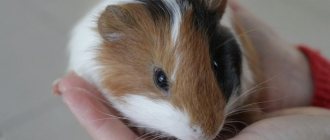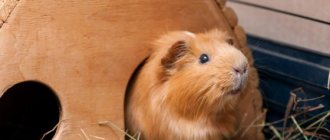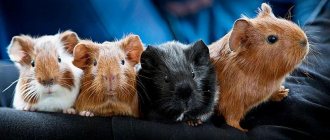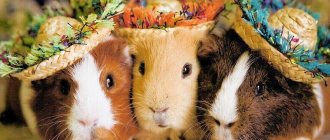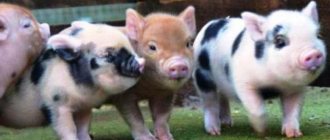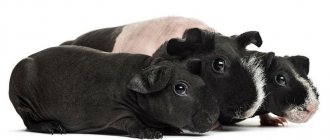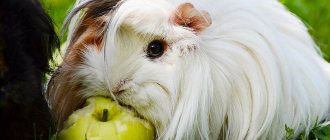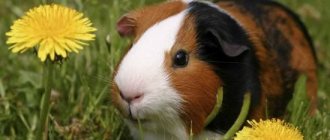A pregnant pig needs the attention and care of her owner more than ever. During the period of bearing cubs and during childbirth, some females die due to improper care, stress, and poor nutrition.
To prevent this, the owner must be able to recognize that his guinea pig is pregnant and know how to help her safely carry and give birth to healthy piglets.
Puberty period
In general, guinea pigs, like other rodents, reach sexual maturity very quickly. Females can give birth to young at 7 weeks of age, and males are ready for fertilization at two months. However, breeders do not recommend trying to get offspring at such an early age - the body of young females is not yet strong enough. Therefore, the risk of complications during pregnancy or childbirth is high.
It is better to wait until 10-12 months - the prime of life for guinea pigs. At this age, no complications usually arise; the offspring are especially strong and numerous.
The main thing here is to choose the right moment for mating. To do this, watch the behavior of the female - she begins to “pose” in front of her chosen one, freeze for a long time, sticking out her butt and spreading her paws. These are sure signs that she is ready to become a mother.
Baby guinea pigs
The weight of a newly born baby can vary from 50 to 120 grams. Cubs are born with open eyes, formed teeth, and just a few hours after birth they are able to walk and even run around the cage. This is another distinctive feature of guinea pigs from other rodents. Babies look like an exact smaller copy of adult animals and can even feed themselves, but without mother's milk the chances of survival are close to zero. Female guinea pigs have only two nipples, so they feed their babies in turns. There is enough milk for the entire litter - be it two or eight cubs. They are good and caring mothers.
Guinea pig with offspring
On full-fat milk, young animals quickly gain weight and within the first two weeks the baby’s weight doubles. On the third day after birth, the animals begin to try food, imitating their mother. At the age of one month, the young animals are placed in separate cages.
Features of choice
To get healthy offspring, the choice of parents should be taken very seriously. Selected individuals must meet the following requirements:
- be moderately well-fed;
- be distinguished by cheerfulness and mobility;
- have a beautiful, thick and shiny coat;
- have pronounced characteristics of the breed;
- not have any diseases.
It is also not advisable for a female to give birth more than twice a year. Otherwise, its lifespan is sharply reduced, and the offspring become weaker. It’s not so simple with males either. Excessively frequent mating leads to exhaustion and even death.
Selection of animals for breeding
It matters a lot. Pigs must be:
- well-fed, active and cheerful, absolutely healthy, have excellent breed qualities, with excellent quality wool of a characteristic color.
A female should not be bred more than twice a year, since frequent “work” undermines her health and, as a result, her offspring will be weak and of poor quality. Uncontrolled use of males will also lead to unpleasant consequences - the potential mother will remain unfertilized.
A week before and during mating, animals are given food rich in vitamin E - sprouted wheat, barley, oats, as well as succulent food. The best time for reproduction is considered to be spring and summer, when there is a lot of varied food.
Obese, overly dense or thin, sick animals should not be allowed to crossbreed.
For one male there should be from 5 to 10 female pigs. Some breeders keep them together, others separately - there is no fundamental difference. In the case of separate keeping, the female during estrus is placed in a cage with a “man”.
The hunt lasts about two days, the frequency of estrus is 13-20 days. The favorable period for fertilization lasts about 10 hours. The female takes a characteristic pose (she is motionless, her hind legs are apart, her croup is raised) and is ready to let her partner approach her.
Mating process
Perhaps the simplest stage, which does not require intervention from the owner. If you notice signs of heat in a female, move the male to her if you keep them separately. In the case when guinea pigs of both sexes live together, even such help is not needed from the owners. Just provide them with maximum peace - do not peek too much, protect them from direct sunlight. You can cover it with a light, light fabric, leaving gaps for ventilation.
Mating usually takes several hours. More precisely, the process itself takes a matter of minutes or even seconds. But to be on the safe side, it’s worth giving a little time for the male to rest and repeat the procedure.
How to care for offspring
If you decide to breed guinea pigs, then it is worth remembering that after the female gives birth, you can pick up the piglets only as a last resort. The mother handles everything else herself and does not require human intervention. Up to five babies are born in a litter, who already have teeth and open eyes, and after an hour the offspring begin to move independently.
The pig has two nipples and the babies take turns sucking milk. If the mother has abandoned the litter, then it is worth transferring the young to another mother. In order for the female to accept the offspring, the fur must be wiped with bedding taken from the nest of the new teacher. In the case of artificial feeding, the procedure is carried out every 120 minutes using a pipette and a special milk mixture.
72 hours after birth, the animals are already trying adult food. Breastfeeding lasts three weeks, after which lactation gradually decreases, and the mother loses interest in the offspring. Young animals are allowed to be placed in a separate cage at the age of 30 days.
Pregnancy symptoms
Outwardly, it is quite difficult to notice signs of pregnancy in a guinea pig, especially in the early stages. But if you carefully monitor the behavior of the rodent, you can install it quite easily.
Pregnant guinea pig
First of all, the female’s appetite sharply increases. She attacks food greedily and can eat three times more than usual. The guinea pig also begins to drink much more. Knowing the initial weight of your pet, regularly weighing her and noticing her constantly increasing weight, you can make sure that the mating was successful.
However, having recorded all these signs of pregnancy in a guinea pig, it would be a good idea to visit a veterinarian. After listening to your pet with a stethoscope, he will tell you for sure whether a new life has arisen in her. Within 2-3 weeks, a good specialist will give you a definite answer.
Possible problems during breeding
- Death of offspring. It occurs for various reasons. One of the most common is that the mother does not accept the babies, which happens due to poor maternal instinct or lack of milk as a result of the stress of childbirth. It is better to cull such females immediately and not allow them to reproduce. Often, a young mother herself can destroy her offspring due to excessive anxiety, when she endlessly drags them around in search of a safe place. Refusal to breastfeed. In this case, the mother is still kept close to the brood, but the babies are fed. After some time, the female can resume feeding. If there are problems with milk production, then it is better to reject such a mother and transfer the cubs to artificial feeding. Birth of stillborn piglets. The reasons are poor maternal feeding, vitamin deficiency, lack of micro-, macroelements or infection.
Breeding guinea pigs at home is not a difficult task at all, but even it should be approached with full responsibility, choosing the right breeders and providing comfortable conditions. Only in this case can you get healthy and full-fledged offspring.
How long does pregnancy last
The next very important question is how long pregnancy lasts in guinea pigs. Knowing the answer to this, the owner will be able to prepare everything necessary for childbirth so that the female feels as comfortable and cozy as possible.
Alas, it is problematic to answer unequivocally here. After all, there are a large number of breeds of guinea pigs. Also, each female may have certain characteristics. Therefore, the minimum period of a healthy pregnancy is 60 days, and the maximum is 70.
Throughout this time, you need to follow certain rules for caring for a pregnant guinea pig:
- do not pick her up unless absolutely necessary;
- do not move the cage from one place to another, and also do not arrange a “redevelopment” by changing places of the house, drinking bowl and feeder;
- keep the amount of cleaning to a minimum.
It is very important to provide maximum rest to your pregnant guinea pig. Any intervention can cause stress, which can trigger a miscarriage.
Even if the rodent previously loved to rest in the arms of its owner, now the usual procedure can cause a completely undesirable result.
Complications during childbirth
Typically, giving birth to a guinea pig does not require much assistance from the owner.
If signs of complications or pathology appear, you should contact your veterinarian:
- the female makes efforts for fifteen minutes, but there is no calf;
- contractions last more than an hour;
- the animal makes too intense screams;
- severe bleeding began;
- there is profuse drooling or foaming at the mouth;
- the fetus gets stuck in the birth canal or goes backwards.
The female itself breaks the amniotic sac and licks the body of the newborn. If the female is inexperienced, she will need help. During the first birth, you sometimes have to help remove the membrane and rub the baby's body with a soft, clean cloth.
After giving birth, it is recommended to place the guinea pig with the newborns in the same box so that the mother gets used to it and begins to feed her offspring. The young are separated from their mother at three weeks of age into spacious cages, forming according to gender.
Share link:
Nutritional Features
As mentioned above, during pregnancy guinea pigs have an excellent appetite - a large amount of useful substances is spent on the formation of cubs, and later on providing them with the required volume of milk.
Accordingly, the diet should be plentiful, varied and satisfying, but at the same time not fatty. Consumption of fat-containing foods may well provoke premature birth or simply disrupt the development of piglets. It is advisable to increase the amount of vegetables, fruits and dry grass in the diet, while simultaneously reducing the amount of dry food.
A pregnant guinea pig's diet should include plenty of vegetables.
Make sure that mint, radishes, radishes, rosemary and parsley do not get into your pregnant rodent's feeder. But you can give more:
- dill,
- raspberry leaves,
- spinach,
- young dandelion leaves,
- beets,
- cumin,
- carrots.
Of the usual grains, oats should be left. If possible, germinate it. This is not difficult to do (just rinse with cold water and leave in a damp cloth in a warm, dark place for several days), and the absorption of nutrients will be much easier.
Caring for a pregnant pig
Guinea pig pregnancy is a very complex physiological process. A complete hormonal change occurs in the body, which leads to increased energy costs. Therefore, during this period, owners should be especially careful about their pregnant pet. The expectant mother should receive a varied, balanced diet, high-quality food, and proper and systematic care.
Feed should contain high concentrations of protein, vitamins, organic, essential acids (lecithin, tryptophan), macro- and microelements (phosphorus, calcium, magnesium, selenium). Give your rodent sprouted oats, wheat, various grains, roots and tubers.
The diet of a pregnant rodent should be nutritious and balanced
The volume of the diet is increased by 1/3 at the beginning of pregnancy and almost doubled at the end of pregnancy. There should always be fresh boiled water in the drinking bowl for drinking. In addition to water, the expectant mother can be given warm milk in small quantities.
There is no need to disturb a pregnant pig again. Stress negatively affects the condition of the guinea pig and weakens the body. If you pick up a female, do it very carefully. There is no need to disturb your pet once again with inspections or frequent cleanings.
It is advisable for the expectant mother to place the piglets in a separate cage during pregnancy, a week before giving birth, and also after birth. In this case, it is best to temporarily move the male or other females to another home. Males can cover the pig immediately after giving birth, which will negatively affect its condition.
Keep the feeders, drinkers, and cage hygiene clean. Three days before the expected date of birth, the rodent's home should be clean, ideally prepared for the birth of the babies. Use soft hay and scraps of paper as bedding. The female will build a birth nest from these materials.
If the pig quickly loses weight, becomes lethargic, apathetic, reluctant to eat, reacts poorly to external stimuli, or the condition of its fur has deteriorated, do not leave the condition of the rodent unattended. Contact and consult with a veterinarian or ratologist (rodent specialist). It is possible that the expectant mother suffers from toxicosis, which, as a rule, manifests itself in the last stages of pregnancy or immediately after childbirth.
How does childbirth go?
Knowing how long pregnancy lasts in guinea pigs, you can accurately calculate the time when the cubs will be born. You need to prepare accordingly for this moment.
First, change the bedding. Both finely torn newsprint and soft hay will do. From such material, the female will be able to build a cozy nest in which she will take care of the newborn cubs.
Be sure to change the water in the drinking bowl and make sure that there is a decent supply - just before giving birth, the female will drink a lot.
A few hours before giving birth, the guinea pig begins to worry - it does not eat, builds a nest, and the rest of the time it sits and cleans its skin.
A rodent gives birth while sitting. Cubs leave the mother's womb at intervals of about 4-5 minutes. Usually the female carefully licks the newborns and removes the amniotic sac.
What to do after childbirth
When the birth is over, you should clean the cage without touching the newborn cubs. If there are dead cubs, they must be removed as soon as possible. Some females may eat them. This shouldn't happen. Don't forget to monitor mommy's diet. A nursing guinea pig needs a balanced diet. Nutrition during breastfeeding is not much different from what it was during pregnancy. Give your pig more grass, vegetables and healthy hay.
ATTENTION! Please note that piglets are born with teeth. This means that they can eat food on their own. But despite this, babies need their mother. They should not be separated, because the mother will feed them milk for a month.
No nutritional supplements can replace healthy mother's milk for piglets. Monitor the location of feeders and drinkers. They need to be positioned so that the piglets can reach them. The water must be fresh and clean. Change it every day. The cage must be arranged so that there is enough space for all new residents. If necessary, purchase new housing for the family
